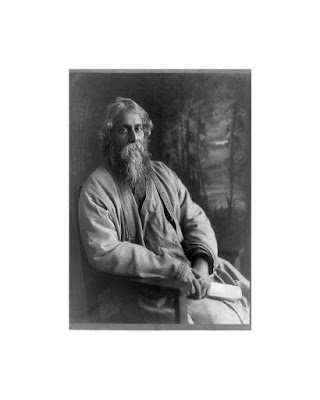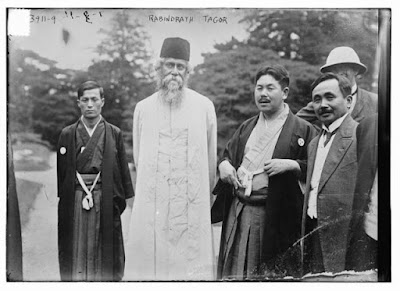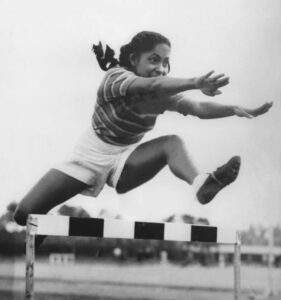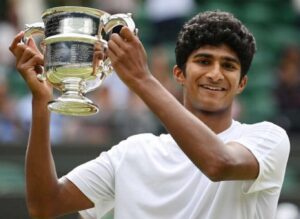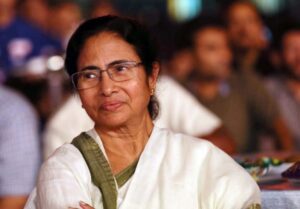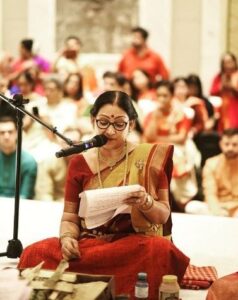Rabindranath Tagore, the first Asian to win the Nobel prize, was a man ahead of his time. He was one of the most creative thinkers of his age in the country. The Bard Of Bengal considered himself a poet, but he was more than that.
Rabindranath Tagore Family
Tagore was born as Robindronath Thakur. Tagores are Rarhi Brahmins and had ancestral gentry roots in the Burdwan district of West Bengal. Their original surname was Kushari.
In years to come, a section of the family moved to the Eastern part of Bengal(present Bangladesh). Later on, their descendants came back to the Western part of Bengal and settled in a small fishing village in the Gobindapur(now part of Kolkata) region around 1720.
In those days, Brahmins were often referred to as Thakur, meaning Lord. British, unable to articulate this unfamiliar name, pronounced it as Tagore. That is how they came to know Tagore.
At the palatial mansion in Jorasanko, Calcutta, Tagore was born on 7 May 1861. Robi, his nickname, was the youngest of 13 surviving children of Debendranath Tagore and Sarada Devi.
The Tagore family was at the forefront during Bengal Renaissance. The family fortune reached its peak in the life of Rabindranath Tagore’s grandfather, Dwarkanath Tagore. He was one of the first Indian industrialists to form a partnership with British traders.
Dwarkanath was extremely rich and lived lavishly. He set up a string of commercial ventures in many fields, indigo factories, coal mines, tea estate, etc. He founded the first modern bank with Indian capital known as the Union Bank in Calcutta.
His father, Debendranath, was a social reformer. He had been a distinguished leader of the Brahmo Samaj movement founded by Raja Rammohan Roy.
The environment at his home was artistic. The spirit of creation was present in the whole atmosphere of their home.
The Jorashanko House was full of poets, scholars, musicians and philosophers, artists, and social reformers. Music was in the air.
His brother, Satyendranath, was the first Indian to break into the elite Indian Civil Service. The oldest brother Dwijendranath was a philosopher and poet.
Another brother, Jyotirindranath, was one of the most accomplished men of his age. He was a dramatist, musician, and composer. His sister Swarnakumari was the first woman novelist of Bengal.
As his father traveled widely and his mother had to look after a big joint family, he was raised mostly by servants. His mother also died in his early childhood.
Early Life Of Rabindranath Tagore
Tagore started writing poetry as an eight-year-old. When Rabindranath was 12, after his Upanayana ceremony, his father took him to the western Himalayas, visiting several places on the way.
At the age of twelve, his first long poem, Abhilash, was published in the family journal without his name. His first public appearance was at fourteen when a newspaper published his patriotic poem.
Jyotirindranath’s wife Kadambari Devi, a little older than Tagore, was his playmate and later became his guiding star. Kadambari Devi was his muse and influenced his poetry. He had dedicated many of his poems to her.
Tagore largely avoided classroom schooling and was educated at home under private tutors. Years later, he held that proper teaching does not explain things but stokes curiosity.
His father, Debendranath, wanted him to become a barrister, so he was sent to England to complete his studies in 1878. But, he left school, opting instead for independent learning of plays of Shakespeare.
In 1880 he returned to Bengal with no academic degree, resolving to reconcile European novelty with Brahmo traditions, taking the best from each.
 |
| Buy Here: Unpublished Poems Of Rabindranath Tagore |
After returning to Bengal, Tagore regularly published poems, plays, and novels.
In 1883, at 22 years old, he married 10-year-old Mrinalini Devi. The couple had five children. The abrupt suicide of Kadambari Devi, soon after his marriage, affected him a lot. Her death taught him the real perspective of the world. Watch the movie depicting their complex relationship with Amazon Prime.
On the command of his father, in 1890, Tagore began managing the interest of vast ancestral estates in Shelidah and Shazadpur(today part of Bangladesh). That was the most fertile period of his creative activity.
As Zamindar Babu, he looked after the interests of family estates. He spent most of the time in a houseboat on the river Padma. He collected mostly token rents and came in close contact with villagers and their constant struggle.
He gained insights into the life of the working class. He got an understanding of the social and economic ills which had crippled their lives. An aristocrat by birth and upbringing, this connected him with the soil of his land.
These insights later became an asset for his success as a short story writer.
This time he became familiar with Baul Lalon Shah, whose folk songs greatly influenced Tagore. Tagore worked to popularise the songs of Lalon.
Rabindranath Tagore Shantiniketan And Visva-Bharati University
In 1901 Tagore moved to Shantiniketan(Abode of peace) to found an experimental boarding school. He wanted to replace the soulless and mechanical education with a creative one in which both teaching and learning are pleasurable. In ancient India, sages lived with their disciples in the ashram and taught them to practice simple living and high thinking.
With his limited resources, the brahmacharya ashram was inaugurated on 22 December 1901 with only a few students, his son being one of them, and an equal number of teachers.
Tagore wanted to bring educational reforms to the country. He considered lack of education to be the main obstacle in the progress of India. He was against bookish knowledge.
The only objective of the education system under colonial rule was to produce clerks to man government offices in India. Education policy completely ignored the promotion of creativity, freedom, joy. Students were not aware of the cultural heritage of the country.
Although both tuition and boarding were free, he found it tough to get enough funds and enough pupils for his schools. For a long time, he bore the full funding for the school. He had to sell his house at Puri, the jewelry of his wife, and royalties from his books to meet the expenses. He implemented the school with limited material resources.
He advocated imparting education in the mother tongue. He participated in all the school activity, and himself taught the children.
Tagore never believed that we could acquire culture from a foreign university but emphasized obtaining scientific knowledge wherever available.
Within a few months of his relocation to Shantiniketan, his wife, Mrinalini Devi, died.
Visva Bharati, Tagore’s conception of a world university, where the whole world meets in one nest, was established in 1921. He was a patriot. He had a determination to go beyond aggressive nationalism and to build friendships with all nations.
Tagore felt that education should make the younger generation aware of their national cultural heritage. At the same time, it should persuade them to learn from the cultures of other countries.
Tagore put great emphasis on educating the entire population in their mother tongue. He did not want education to remain confined to the cities and particular classes of society. He put great emphasis on the education of women.
He modeled the program of rural development on twin principles of self-help and enlightenment. He helped the peasants to build their schools and hospitals, roads, set up cooperative enterprises, and banks.
Later, five-year plans of India for rural community development adopted this program for rural development.
He firmly believed that freedom and innovation are linked. Education must develop the intellect as well as the creativity of a student.
Rabindranath Tagore’s Ideas On Nationalism
Tagore denounced the British Raj, and from time to time, participated in the Indian nationalist movement. He protested against the partition of Bengal in 1905. He made fiery speeches, composed patriotic songs, and lead huge processions to show his support.
He abandoned the struggle when it moved towards violence. He had to face severe criticism for this action.
It was Tagore who addressed Gandhiji as Mahatma for the first time during his visit to Santiniketan. Although they disagreed on a range of issues related to the freedom struggle, nationalism, and politics, they remained devoted friends.
He won the 1913 Nobel Prize in Literature. He was the first Indian,non-European as well as the first lyricist to get this coveted award. He donated the entire prize amount to his school.
Two years after this, he was awarded a knighthood by King George V. Tagore renounced it in 1919 to protest against the Jallianwala Bagh massacre. Mahatma Gandhi called him the Great Sentinel, the one who never fails to protest against any injustice or wrong.
Tagore was against the abnormal caste consciousness and untouchability. He wrote about the injustice perpetrated to the Hindu woman in the name of holy scriptures and traditions. He made them the heroes for his poems and dramas.
He was the severest critic of its social institutions and religious practices that encouraged superstition, inequality, and injustice.
He mourned the socioeconomic decline of Bengal and the perennial poverty of Calcutta.
Between 1878 and 1932, Tagore sailed to more than thirty countries on five continents. He introduced the Indian culture to the West and met many intellectuals in the countries he visited. That led him to emphasize co-operation between East and West in the field of humanistic studies.
Where the mind is without fear,
and the heart is held high,
Where the world is not broken up into fragments
by narrow domestic walls,
Where the words came out
from the depths of truth,
Where tireless striving stretches its arms
towards perfection;
Where the clear stream of reason has not lost its
way into the dreary desert sand of dead habits,
Where the mind is led forward by thee into
ever widening thought and action –
Into that heaven of freedom,
My father, let my country awake.
Works Of Rabindranath Tagore
He was the first to use colloquial language in Bengali literature. Modern short stories are his gift to Indian Literature.
The vital theme of his poems was nature and love. Equal importance was given to verses, dealing with national, social, and religious problems. These categories merged into one another.
 |
| Buy Here: Rabindranath Tagore’s Books |
Gitanjali, Gora, and Ghare-Baire are his most popular works.
Kabuliwala became one of the most lovable characters in Bengali fiction. The characters in his stories were real and vivid.
He started a new genre in Bengali music, known as Rabindrasangit. His song collections, Gitabitan, contains 2,265 songs that were all composed, tuned, and sung by himself,
Gurudev remained a student throughout his life. At the age of 70, Tagore developed a passion for painting.
He is the only person in history whose compositions are chosen by two nations as national anthems: Jana Gana Mana of India and Amar Shonar Bangla of Bangladesh. The Sri Lankan national anthem is also largely influenced by his work.
End Of An Era
A period of illness marked his last five years. Critics believed that poetry from these years is among his finest.
At the age of 80, on 7 August 1941, he died in the same Jorasanko mansion in which he grew up.
